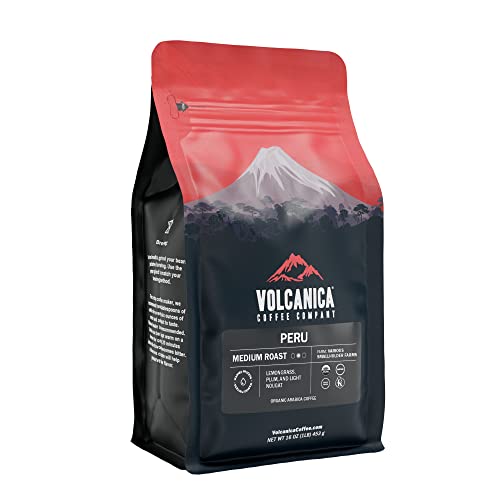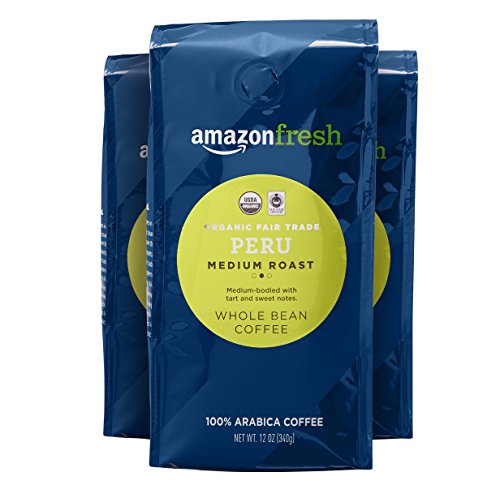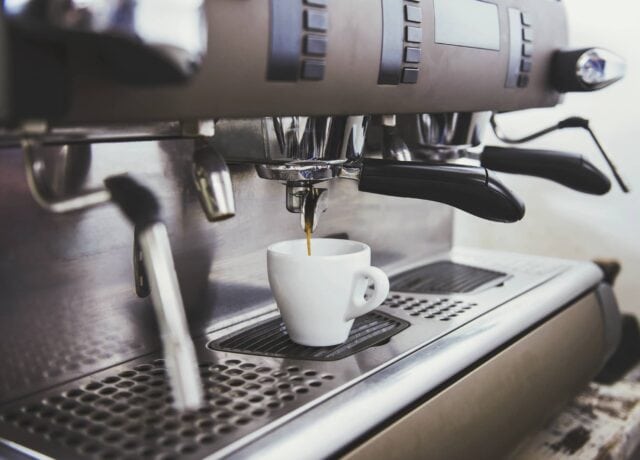Any dedicated coffee connoisseur can tell you that if you want to experience delicious single-origin coffee, then you can’t pass up Peruvian coffee.
Carefully grown and cultivated by some of the most hands-on, experienced farmers in the coffee industry, Peruvian coffee has grown to be one of the most well-recognized coffees in the world.
At a Glance: Best Peruvian Coffee
Quick Summary: Best Peruvian Coffee
 | Our Top Choice
Volcanica Peruvian Coffee
| Check on Amazon → |
| No products found. | Fresh Roasted Coffee Peru | Check on Amazon → |
 | Café Altura Peruvian Coffee | Check on Amazon → |
 | Java Planet Decaf Peruvian Coffee | Check on Amazon → |
 | Cubico Coffee: Peru | Check on Amazon → |
 | AmazonFresh Organic Peruvian Ground Coffee | Check on Amazon → |
In the Beginning…
Peru became one of the first countries in South America to host coffee, which arrived in the country in the mid-1700s. Coffee was originally grown in Peru for domestic consumption during the late 1800s. Brought over from its neighbor, Ecuador, the crop began as a small scale production along the western coast. It was typically grown along the western coastline and was primarily grown for domestic consumption.
It can be easily overlooked by some of its larger coffee competitors in South and Latin America such as Brazil, Guatemala, and Honduras. However, as of 2018, Peru was listed as the 11th largest coffee producer in the world, and 5th in the exportation of arabica beans. Usually, the crop is cultivated on a large scale primarily by small-scale farmers, normally being handpicked and hand-processed.
Flavor Overview
Almost all of the beans that are grown and exported in Peru are arabica beans. Typically, these beans are sweet, bright, mellow in flavor, and mild in acidity. In addition, they are lighter in body, and have numerous variations of flavor profiles that will satisfy any palate. Sweet and vibrant, the flavor is perfect to drink on its own as a black coffee, or with whatever additions you add to it.
Furthermore, many Peruvian beans are organic since many small farmers do not have access to chemical fertilizers or pesticides that other, larger-scale farmers have. Subsequently, this also helps preserve the flavor of the beans.
Top Pick Peruvian Coffees
With such an interesting background and flavor profile, Peruvian coffee is worthy enough to be on every coffee lover’s list of coffees to try. Here are some of the most delicious Peruvian blends that you can experiment with on the market today.
Volcanica Peruvian Coffee
Made of 100% arabica coffee, this Peruvian blend by Volcanica is planted by farmers at elevations over 3,000 feet. A medium, full-bodied roast, this blend is rich in complex flavors and floral, smokey overtones. It also possesses a clean, bright finish, and it easy on the acidity.
Volcanica also ensures that every bag is packaged by workers immediately after roasting, and that every order is roasted on the same day that the order is placed. Each bag also has the option of whole bean or ground coffee, making it more available to home coffee drinkers, regardless of whether they have their own coffee grinder.
Fresh Roasted Coffee Peru
Possessing warm cinnamon with caramelized sweetness, this organic roast by Fresh Roasted Coffee has a bright flavor profile of caramel and orange. It is a medium roast that’s bold in body and is fully washed and dried in the sun, Fresh Roasted ensures that every batch of their roasted coffee is as flavorful as can be.
Sourced from Cajamarca, Peru, this is an organic blend that isn’t only available in whole beans and grounds, but is also available in K-cup, single-serve sizes. So no matter what method of brewing you prefer, this blend will suit any of them.
No products found.
Café Altura Peruvian Coffee
A darker roast, this Peruvian coffee by Café Altura is vibrant in flavor with a pleasant aroma. It’s the perfect way to start off your day and is enjoyable both hot or cold. As far as growing conditions are concerned, farmers will usually grow them at elevations over 3,000 feet.
Furthermore, each batch is roasted in small amounts in order to ensure that every batch has a steady, robust, consistent amount of flavor. This blend is also easy on the acidity, making it enjoyable to sip on during any time of day.
Java Planet Decaf Peruvian Coffee
Can’t have caffeine? Have no fear! This decaf Peruvian roast from Jave Planet will give you all of the normal flavors of Peruvian coffee, without the consequences of caffeine consumption. Completely organic and USDA certified, every batch by Java Planet is guaranteed unaltered with harmful pesticides or fertilizers of any kind.
A medium-dark roast, this blend has robust flavors with notes of chocolate and walnuts. In addition to this, Java Planet’s Decaf also has a silky-smooth mouthfeel with every sip. The acidity in this blend is also very gentle, making it easily drinkable for the coffee lover with a sensitive stomach.
Cubico Coffee: Peru
Produced by CENFROCAFE, Cubicao Coffee’s Peru blend is cultivated in the northern highlands of the country. It’s a medium roast with an intense citrus flavor, accompanied by nutty, toffee-like sweetness with mild herbal notes. After farmers harvest the beans, the farmers then wash and sun-dry them before the roasting process begins.
Every bag is roasted in small batches and labeled with the date of roasting in order to monitor freshness. It’s higher in acidity and lighter in the body, but the flavor and aftertaste are well-balanced.
AmazonFresh Organic Peruvian Ground Coffee
Fair Trade Certified, Amazon also has its own coffee-roasting side gig, and Peruvian coffee is just one of its specialty roasts. A medium roast with a silky finish, each batch is made up of 100% arabica coffee beans. It has a milder acidity, with a robust flavor and chocolate overtones.
It is overall very well-balanced, not too bitter and not too powerful of an aftertaste. Not only is this roast great for drip coffee, but it’s bold enough to also be used for espresso brewing.
Climate and Cultivation
Most farmers will plant their coffee crops in shady, high elevated areas. Normally, farmers will plant their crops between 3200-6000 feet. This ensures that the beans are as flavorful as can be, since growing them at higher elevation forces the beans to “fight” to grow. The struggle that the beans must go through forces them to produce more sugars and nutrients that attribute a flavor profile to the bean.
Normally, harvesting times for Peruvian beans ranges between March and September. Once these beans have been harvested and sorted through, usually by hand, they are prepped for processing. Most farmers in Peru utilize the wet processing method, fermenting their beans in order to highlight and bring out the inner tones of flavor in the beans.
However, with so many farmers cultivating coffee on such a small scale, it can be difficult to export their beans to a global market. Due to this issue, many of these farmers are now participating in fair-trade cooperatives. These cooperatives are groups of farmers that work together to create an agricultural market, buy, sell, and negotiate coffee prices, and cooperate to better access international markets. One of the largest cooperations in Peru is CENFROCAFE.
What is CENFROCAFE?
If you’ve done even the smallest amount of research about Peruvian coffee, you’ll immediately discover something called CENFROCAFE. This is a cooperation of more than 80 farm associations and is one of the largest cultivators of Peruvian coffee. This is one of the largest cooperation of farmers in Peru today.
Founded in 1999, it originally began with 220 small-scale farmers in local communities working together to cultivate coffee crops on a large-scale basis. Today, CENFROCAFE encompasses more than 2,000 farmers, all of whom have land that spans across the lush Cajamarca region.
However, much of the infrastructure in the country is underdeveloped. As a result, most farms are located in areas where there is limited access to roads and running water. Due to this, many farmers with CENFROCAFE coffee grow about 92% completely organic beans, which are all Fair Trade Certified.
Luckily, with the progression of the 21st century, many local farmers are receiving funding from both the Peruvian government and private individuals/groups to financially support new infrastructure for the coffee industry. As a result, Peru is now one of the leading cultivators and exporters in the world today.
Climate and Cultivation
Farmers will plant most coffee crops in shaded areas that are higher in elevation. Normally, the ideal height for planting occurs between 3200-6000 feet. This ensures that the beans are as flavorful as can be, since growing them at higher elevation forces the beans to “fight” to grow. The struggle that the beans must go through forces them to produce more sugars and nutrients that attribute a flavor profile to the bean.
Common Growing Regions
In Peru, there are several regions that are specifically dedicated to agriculture and farming. Since coffee is a large exportation crop, there are several regions that are prominent are located in the eastern part of the country and the southern highlands. Aside from the Highlands, the other essential growing regions are the Andes, Chanchamayo, Amazonas, and the San Martin regions.
Andes
The largest continental mountain range in the world, the Andes Mountains embody some of the richest environments and agricultural regions in the world. However, when it comes to cultivating coffee, this region produces some of the most flavor-filled beans in the country. Most coffee beans from this area come from smaller farms, only about 2-3 hectares in size, and are grown anywhere between 3200-6000 feet in elevation.
Chanchamayo
The Chanchamayo Valley is located in the middle of the country. Known for producing some of the highest quality beans in Peru, the fertile valley is positioned around the Andes Mountains. Farmers plant beans here at an elevation of around 5,000 feet and are normally light-medium bodied with hints from chocolate and nuts to fruity citrus.
Amazonas
Found in the northern part of Peru, the Amazonas is a high-elevation area, making it ideal to grow coffee beans there. Typically ranging between 5700-6500 feet above sea level, these beans have notes of citrus, berries, and has a creamy body with a slight chocolate finish.
San Martin
Also located in the northern highlands of Peru, the San Martin region encompasses the Huallage River, the Andean Plateau, and numerous hills and ravines across the landscape. It is the third-largest coffee growing region in Peru, and it continues to grow each year. Furthermore, this region is an organic, agricultural climate. This is due to the lack of running water and chemical/mechanical influences.
Southern Highlands
The Southern Highlands is an area that accounts for about 23% of the country’s total coffee production. These Highlands are high enough in elevation to host a healthy climate for coffee plants, and many farmers located here also tend to their crops by hand, nurturing their beans from the time they’re planted until they’re shipped for export.
How To Brew Peru
With such a vibrant yet gentle amount of flavor, Peruvian beans are highly versatile when it comes to methods of brewing. Especially when workers roast the beans to a darker tone, they can create a smooth, silky, robust cup of coffee. So, here are just a few brewing methods that we suggest to bring out as much flavor as possible in your Peruvian coffee:
French Press
The French press is a worthy contender for brewing options due to its ability to create a rich, saturated cup of coffee. Since it uses the process of immersion, baristas blend the coffee grounds with the hot water to extract as much flavor as possible from the grounds. If you’re grinding your coffee beans yourself, it’s recommended to use a coarser grind size.
Pour-Over
For the lover of the pour-over, Peruvian coffee just might become your favorite go-to coffee. The primary reason many baristas prefer the pour-over is because it allows manual control over the brewing process. The “blooming” of the coffee releases all of the fruity, chocolatey, nutty notes hidden within the grounds.
Espresso
If you want your espresso to pack a punch-full of flavor, then Peruvian coffee is a great option to use. For espresso brewing, you need to grind your Peruvian beans to a finer size. This will allow the hot water that’s forced through the portafilter of your espresso machine to extract all the flavor needed to produce sharp, strong Peruvian espresso.
Traditional Peruvian Coffee
Whether you’re a coffee lover who’s traveling to Peru to enjoy Peruvian coffee, or you just want to experiment with traditional Peruvian coffee in your own home, you’ll need to know some information about these specialty drinks. There are typically two styles of traditional Peruvian coffee that you can enjoy: café and pasado.
Café
Many natives enjoy this drink, whether in the marketplace or in a local restaurant. However, in the restaurant setting, you’ll likely receive a cup of hot water along with a serving of instant coffee. Since Peruvian beans pack so much flavor in them, they are normally just combined with water, unfiltered, and then consumed.
Pasado (Cold Brew)
This is a Peruvian cold brew, which the barista will normally brew for up to 12 hours. Typically, people will often brew pasado in a closed jar, stirring it and shaking it to saturate the grounds.
Pasado (Short Brewed)
The Short-Brewed version takes less amount of time and is done with boiled water that if filtered very slowly through coffee grounds. As a result, it creates a powerful concentrate that you can enjoy by itself, or you can dilute it and mix it with other liquids.
Peruvian Poop Coffee
If you’re interested in really organic coffee, then you might want to take a very open-minded look at poop coffee. Yep, you read that right.
Considered the most luxurious coffee in the world, dung coffee has spiked in popularity over the last several years. The two most popular animals that produce this are the coati (uchunari) or the civet (kopi luwak). However, this exotic and bizarre brewing can get pricey. Uchunari coffee averages around $80 per pound, and kopi luwak can reach up to $500 a kilogram.
This is because many coffee fanatics believe that coffee passed through the animal’s digestive tract is less bitter, yet is full-bodied and is enhanced with the flavors of the animals’ diet. For example, these enhancements include flavors like fruits, citrus, earthy nutty tones, and herbal and vegetation influences. Farmers feed the beans to the animals for consumption. Afterward, the farmers collect the undigested beans from the animal feces, rinse them, and then begin roasting.
Current Coffee Conditions in Peru
Today, the coffee industry has created a little under a million jobs in Peru. With a significant amount of government influence, the coffee industry in the country has skyrocketed. For instance, the coffee industry has grown from domestic markets to international markets, and Peru now has an estimate of 100,00 farmers. The top consumer of Peruvian coffee in the world today is the United States.
One of the largest sources of agricultural income for the country, the economic influence of the coffee industry is undeniable. As a result of the demand for Peruvian coffee, there has also been a spike in construction and infrastructure. Likewise, with the steady increase in the quality of and amount of infrastructure, coffee production can continue to grow.
As far as the future is concerned, the future of Peruvian coffee is bright. Nowadays, Peru is a country on the rise. Likewise, with such a high demand for coffee, the coffee industry won’t be slowing down any time soon.
Wrapping Up
Ultimately, Peruvian coffee is one of the greatest coffees that any coffee connoisseur can get their hands on. Outstanding in flavor, light acidity, and full-body, Peruvian coffee is vibrant, smooth, and refreshing with every sip.
If you haven’t tasted it already, its absolutely worth a try. And if you’re feeling experimental, then uchunari or kopi luwak will definitely to your list of exotic coffees to taste. Regardless of how you decide to try it, Peruvian coffee is available in many roasts and blends for everyone to experience.













